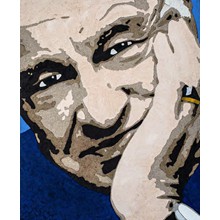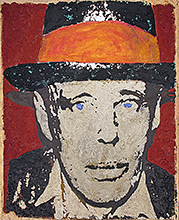The Transformative Power of Artist Ruggiero
Casa Italiana Zerilli-Marimò opened its new season this September with the original exhibit Huge portraits and abstract paintings adorn the corridor of Casa Italiana Zerilli-Marimò: they are what Fabrizio Ruggiero refers to as ‘effigies’, the representation of specific person people. “The Transformative power of Art” is a series of huge portraits and paintings that were first exhibited at the United Nations in June 2015.
|
|
|
Stefano Albertini, Fabrizio Ruggiero and Idanna Pucci
|
|
|
The Transformative Power of Art in ciew at Casa Italiana Zerilli-Marimò |
|
Now, until the end of October, it will be possible to admire them at La Casa Italiana. The artist,born and raised in Naples, was always fascinated by the nature of the places where he grew up. After graduating in architecture he began to travel and work in the fields of art and design: India, Africa and Asia. These travels influenced his creativity and moved his attention to people that have affected the world on a humanitarian and social level, and they became his inspiration: musicians, poets, writers, Nobel peace prize winners. People that have been, and some continue to be, pillars in the global development. For example, among some familiar faces, we find: Malala Yousafzai (Pakistan), Sebastião Salgado (Brazil), Miriam Makeba (South Africa), Gong Li (China), Joan Baez (USA), Joseph Beuys (Germany) and Maya Angelou (USA). The distinctiveness of these works is centered on the use of painting materials like sand, lime and natural pigments, and the return of an old technique, “Fresco”, where the painting is executed on wet lime plastered wall, in fact still ‘fresco’ (which in Italian means fresh), that gives the work itself opacity rather than lucidity. “Technology” the artist says “helps my way of making art, it wouldn’t be otherwise possible for me to work this way”. With regards to the huge abstract pictures, we can’t miss the parallelism with the maestro of contemporary art Alberto Burri, who breaks the rules by using burlap and lime for his works. The art of Fabrizio Ruggiero is therefore 'defined' between two apparently distant worlds: precisely, that of the ancient technique of the fresco and that of most contemporary ties to the master Burri. The focus of this exhibition is not just on abstract art and on the paintings themselves, but also on portraying what the concept of painting is today. Ruggiero wants to direct the attention of the spectators to the meaning of contemporary painting, a blend of social values, artistic skills and technological tools. M. T. (September 17, 2015) |







.jpg)